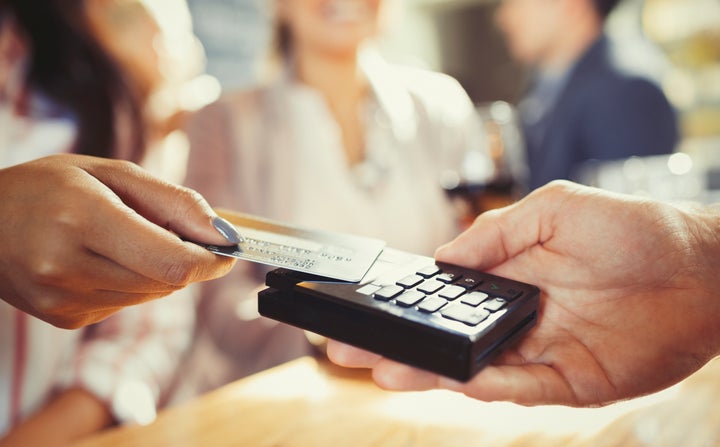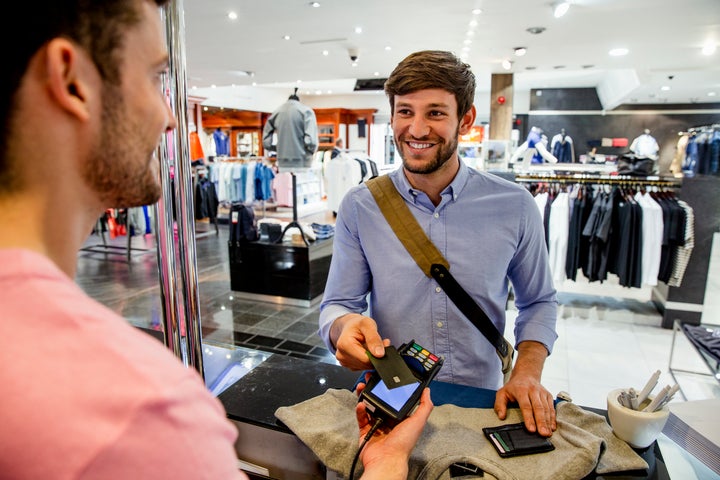It’s 11 years since contactless cards were first launched back in 2007. At the time, they were a niche product only available from one card issuer in a handful of London postcodes.
Today contactless has dramatically changed the way we spend money with the majority of debit cards carrying the wifi-esque logo for easy shopping.
Just look at the stats. Usage of contactless has essentially doubled from 2016 to 2017, with £23.23 billion being spent contactlessly in the first half of 2017 (up from £25 billion for the whole of 2016), according to the UK Finance Authority which represents the banking and finance industry.

It’s easy to spend (and overspend)
Contactless cards are a quick and convenient way to pay for items of £30 and under. And now the £5 minimum payment has been removed, there are even more opportunities to tap and go.
Your card contains a chip that holds your account information and an antenna (copper wire around the card edge) which picks up power from the signal sent out by the card reader. When the card recognises the reader it will ‘reply’ with a coded data transfer and an instantaneous confirmation that payment has been successful.
If you think of how many times you’ve made a contactless payment today, chances are it’s a little shocking. Your daily commute, your morning coffee, a lunchtime sandwich, quick ‘necessity’ buying in Boots or a supermarket, followed by your evening meal and drinks; all paid for with a vague wave of your card over the reader.
And therein lies the peril of paying with contactless: it’s just so easy to spend (and overspend). Those daily unthinking transactions all add up. And when you’re scrolling down your bank statement, it’s the £3.99 spend here, the £10.50 there that are frittering away your finances.

The security features don’t stop you spending
In theory, contactless cards are safe from fraud. Card issuers restrict the number of contactless transactions that can be made before a PIN is requested.
But when the consumer magazine Which? asked volunteers to use their contactless cards on the high street, spending between £20 and £30 each time, and to keep shopping until they were asked for a pin, the results were mixed. They discovered that while most banks asked for a pin after three to five transactions, some debit card providers allowed them to spend more than £200 through 10 consecutive transactions in just three hours.

Delayed payments make you think you have more money than you actually have
Another problem with contactless payments is they can be made offline, so they can be batched and processed without the coffee shop, corner store or independent shop contacting your bank first.
This explains why sometimes there will be a delay of days before a payment is deducted from your account, potentially leading to you overspending without realising payments haven’t appeared yet and even going into the red and incurring bank charges.
You probably don’t wait for a receipt
Thanks to the simplicity and time-saving nature of contactless, many of us don’t bother waiting for a receipt or aren’t even offered one when using contactless.
It may speed up our shopping, but it means that if you want to return anything because you’ve realised you don’t need or want it, you’re stuck. You have to hope the shop accepts returns without a receipt and go through the faff of finding the transaction on your bank account.
While a whole generation of us have grown up with the convenience of contactless, there is a simple way to stay in control of our spending – good old-fashioned cash.
Take out a budgeted amount for the week, put your card away somewhere safe (but not in your pocket or purse!) and see how you go. Using contactless less can help you really see how quickly your hard-earning money goes (and hopefully spur you to make some changes).
Plus, the ever so slightly slower pace of finding notes and coins and waiting for change and a receipt does make you think more about what you’re buying and whether you really need it. It’s well worth it.